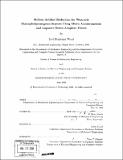| dc.contributor.advisor | H. Harry Asada. | en_US |
| dc.contributor.author | Wood, Levi Benjamin | en_US |
| dc.contributor.other | Massachusetts Institute of Technology. Dept. of Mechanical Engineering. | en_US |
| dc.date.accessioned | 2009-03-16T19:51:35Z | |
| dc.date.available | 2009-03-16T19:51:35Z | |
| dc.date.copyright | 2008 | en_US |
| dc.date.issued | 2008 | en_US |
| dc.identifier.uri | http://hdl.handle.net/1721.1/44855 | |
| dc.description | Thesis (S.M.)--Massachusetts Institute of Technology, Dept. of Mechanical Engineering, 2008. | en_US |
| dc.description | Includes bibliographical references (p. 73-74). | en_US |
| dc.description.abstract | The photoplethysmogram (PPG) is an extremely useful wearable sensing medical diagnostic tool. However, the PPG signal becomes highly corrupted when the wearer is in motion, rendering the measured signal useless. This thesis develops an adaptive motion artifact reduction scheme to recover the underlying physiologic information from the corrupted signal using a collocated accelerometer as a motion reference and adaptively estimating the motion-to-artifact system dynamics. It has previously been shown that this artifact reduction scheme can be utilized, but many tunable parameters were required to model the system dynamics and performance was poor. This work quantifies algorithm performance based on confidence in the estimated system dynamics, which shows low confidence using the previous parameterization when the wearer is jogging. To improve confidence, the form of the system dynamics is established and a Laguerre series is implimented to compactly represent the system dynamics using just a few parameters that can be confidently estimated. Using the new model, heart rate and amplitude can be estimated from typical jogger data with variance similar to separate PPG sensors located on contralateral motionless hands. The standard artifact reduction scheme does not work when the physiologic signal is correlated with wearer motion. Since the signals may become correlated, this work develops a method of recovering the physiological signal even when it is correlated with wearer motion by adapting blind source seperation techniques. However, the success of this new method is limited. | en_US |
| dc.description.statementofresponsibility | by Levi Benjamin Wood. | en_US |
| dc.format.extent | 74 p. | en_US |
| dc.language.iso | eng | en_US |
| dc.publisher | Massachusetts Institute of Technology | en_US |
| dc.rights | M.I.T. theses are protected by
copyright. They may be viewed from this source for any purpose, but
reproduction or distribution in any format is prohibited without written
permission. See provided URL for inquiries about permission. | en_US |
| dc.rights.uri | http://dspace.mit.edu/handle/1721.1/7582 | en_US |
| dc.subject | Mechanical Engineering. | en_US |
| dc.title | Motion artifact reduction for wearable photoplethysmogram sensors using micro accelerometers and laguerre series adaptive filters | en_US |
| dc.type | Thesis | en_US |
| dc.description.degree | S.M. | en_US |
| dc.contributor.department | Massachusetts Institute of Technology. Department of Mechanical Engineering | |
| dc.identifier.oclc | 301739805 | en_US |
